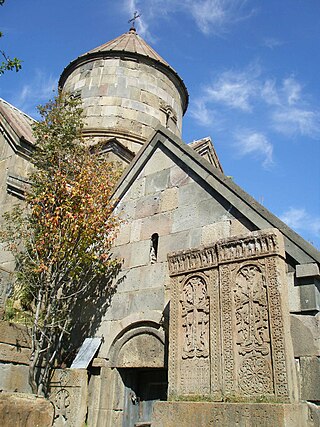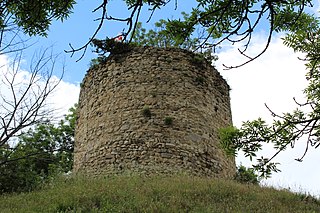A conical roof or cone roof is a cone-shaped roof that is circular at its base and terminates in a point.
A conical roof or cone roof is a cone-shaped roof that is circular at its base and terminates in a point.
Conical roofs are frequently found on top of towers in medieval town fortifications and castles, where they may either sit directly on the outer wall of the tower (sometimes projecting beyond it to form eaves) or form a superstructure above the fighting platform or terrace of the tower. The latter necessitated the use of spouts to lead the water away over the top of the walls (e.g. as at Andernach's Alter Krahnen). In this case the cone roof was surrounded by a defensive wall, a parapet or a battlement. Such conical roofs were usually constructed using a timber-framed support structure covered with slate; more rarely they were made of masonry.
A small circular turret or tourelle with a conical roof is called a pepperpot or pepperbox turret. [3]
Today, conical roofs are more often used in rural areas either for circular or small square buildings. They are difficult to construct but use locally available materials. [4]
Conical roofs are widely used in Armenian and Georgian church architecture. [5] [6] [7]
A key feature of the Solomon Islands Parliament Building is its conical roof.

Romanesque architecture is an architectural style of medieval Europe that was predominant in the 11th and 12th centuries. The style eventually developed into the Gothic style with the shape of the arches providing a simple distinction: the Romanesque is characterized by semicircular arches, while the Gothic is marked by the pointed arches. The Romanesque emerged nearly simultaneously in multiple countries ; its examples can be found across the continent, making it the first pan-European architectural style since Imperial Roman architecture. Similarly to Gothic, the name of the style was transferred onto the contemporary Romanesque art.

A dome is an architectural element similar to the hollow upper half of a sphere. There is significant overlap with the term cupola, which may also refer to a dome or a structure on top of a dome. The precise definition of a dome has been a matter of controversy and there are a wide variety of forms and specialized terms to describe them.

A spire is a tall, slender, pointed structure on top of a roof of a building or tower, especially at the summit of church steeples. A spire may have a square, circular, or polygonal plan, with a roughly conical or pyramidal shape. Spires are typically made of stonework or brickwork, or else of timber structures with metal cladding, ceramic tiling, roof shingles, or slates on the exterior.

A tented roof is a type of polygonal hipped roof with steeply pitched slopes rising to a peak. Tented roofs, a hallmark of medieval religious architecture, were widely used to cover churches with steep, conical roof structures.

Konye-Urgench, also known as Old Urgench or Urganj, is a city of about 30,000 inhabitants in north Turkmenistan, just south from its border with Uzbekistan. It is the site of the ancient town of Gurgānj, which contains the ruins of the capital of Khwarazm. Its inhabitants deserted the town in the early eighteenth century in order to develop a new settlement, and Konye-Urgench has remained undisturbed ever since. In 2005, the ruins of Old Urgench were inscribed on the UNESCO List of World Heritage Sites.
This page is a glossary of architecture.

In architecture, a vault is a self-supporting arched form, usually of stone or brick, serving to cover a space with a ceiling or roof. As in building an arch, a temporary support is needed while rings of voussoirs are constructed and the rings placed in position. Until the topmost voussoir, the keystone, is positioned, the vault is not self-supporting. Where timber is easily obtained, this temporary support is provided by centering consisting of a framed truss with a semicircular or segmental head, which supports the voussoirs until the ring of the whole arch is completed.

The architecture of Georgia refers to the styles of architecture found in Georgia. The country is exceptionally rich in architectural monuments. Characteristic features of the Georgian architecture are monumentality, clear composition, strict proportions, moderate use of decorations, and above all these the harmonic interaction with nature.

Makravank is an Armenian church-complex located in the Makravan district of Hrazdan, the capital of Kotayk Province, Armenia. The monastic complex includes a half-ruined 11th-century chapel. The 13th-century church dedicated to Surb Astvatsatsin has a circular tambour and a conical cupola. The complex also includes the lower walls of the gavit and a medieval cemetery.

The Church of Shoghakat was erected in 1694 by Prince Aghamal Sorotetsi during the reign of Catholicos Nahabed I in the city of Vagharshapat (Etchmiadzin), in Armenia's Armavir Province.

Sanahin Monastery is an Armenian monastery founded in the 10th century in Sanahin in the Lori Province of Armenia.

Holy Mother of God Cathedral of Avan is a ruined 6th-century church located in the Avan District of Yerevan, the capital of Armenia. It is the oldest surviving church inside Yerevan's city limits.
Armenian church architecture is the architectural style of the Armenian church buildings created since the Apostolic era of Christianity in the Armenian Highland during the 1st century. It was developed over the last 1900 years. According to professor Dickran Kouymjian, the unique national style of Armenian church architecture came into being by the late 6th or early 7th century, probably becoming the first national style in Christian architecture, long before the Byzantine, Romanesque and Gothic or the less known Ethiopian, Scandinavian and Slavic styles were concretely formed.

Persian domes or Iranian domes have an ancient origin and a history extending to the modern era. The use of domes in ancient Mesopotamia was carried forward through a succession of empires in the Greater Iran region.

A tholos, in Latin tholus, is a form of building that was widely used in the classical world. It is a round structure with a circular wall and a roof, usually built upon a couple of steps, and often with a ring of columns supporting a conical or domed roof.

The Zemo Nikozi church of the Deity, also known as Ghvtaeba (ღვთაება), is a medieval Georgian Orthodox cathedral in the Gori Municipality, in Georgia's east-central region of Shida Kartli. It is part of the complex which also includes a bell-tower, an episcopal palace, and a circuit wall. The complex is inscribed on the list of Georgia's Immovable Cultural Monuments of National Significance.

The Bochorma fortress is a medieval architectural complex in eastern Georgia, located in the Tianeti Municipality in the region of Mtskheta-Mtianeti. Historically it was part of principality of Kakheti. Situated on a high mount on the Iori River, the complex consists of a castle and a domed dodecagonal church, both dated to the 10th century, as well as another small hall church, and some other accessory structures. All structures within the complex are half-ruined or significantly damaged. They are all inscribed on the list of the Immovable Cultural Monuments of National Significance.

A cap-house is a small watch room, built at the top of a spiral staircase, often giving access to a parapet on the roof of a tower house or castle. They provided protection from the elements by enclosing the top of the stairway, and sometimes incorporated windows or gun loops. They were built in various forms, including square turrets, simple boxes, or small houses with gabled roofs, which were sometimes large enough to provide accommodation for a look-out.
Kenimadala is an architectural term utilised in medieval Sinhalese timber structures. It is used to describe the circular roof plate or structural member where the rafters, śalākā, connect at the apex of a domed or conical roof. The roof of a dageba or cetiya, above the stupa were generally domical in shape and were constructed of timber rafters which were held together on the top by means of a circular boss or kenimandala.
Today the monastery's main church building is a 13th century rectangle in the Armenian fashion, topped with the usual conical dome...
Lalish is dotted with conical holy structures
This conical dome is a characteristic of Armenian and Georgian architecture as is the bulb of Russian; it is universal except in some of the earliest buildings.
...the conical roof, which, as he pointed out, is typical of Armenian architecture.
The characteristic dome consisted of, exteriorly, a tall drum or polygonal cylinder with a conical roof...